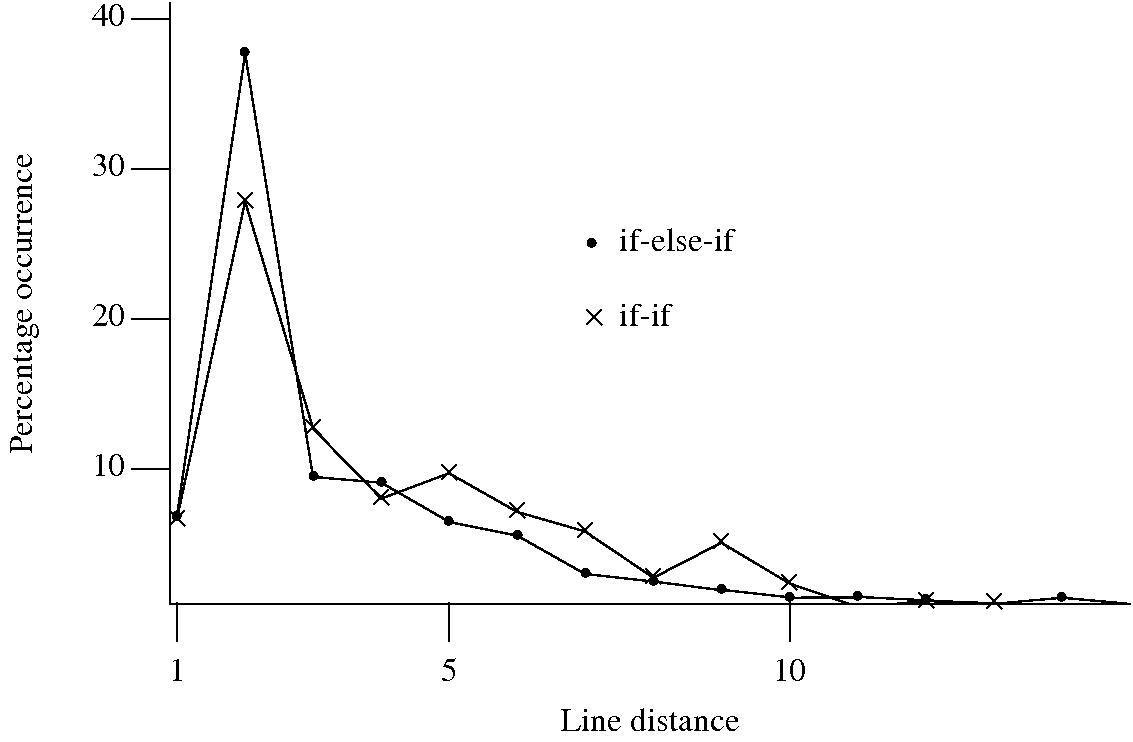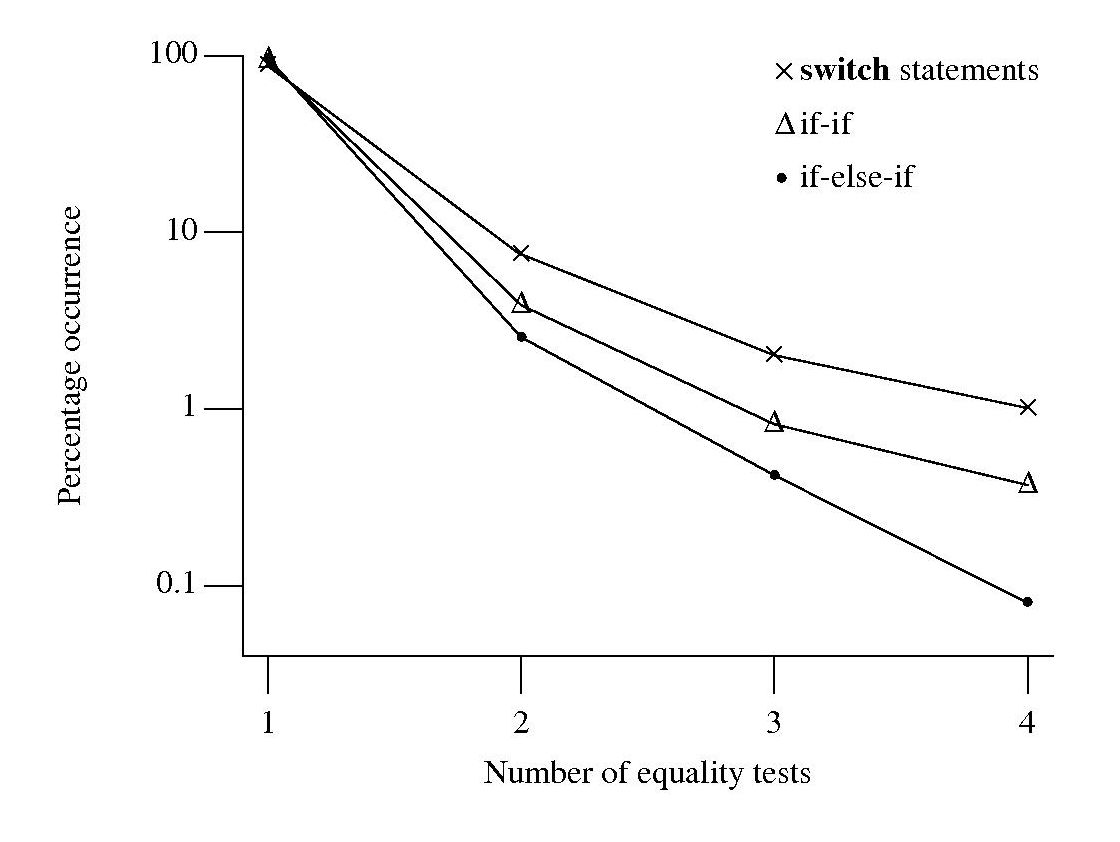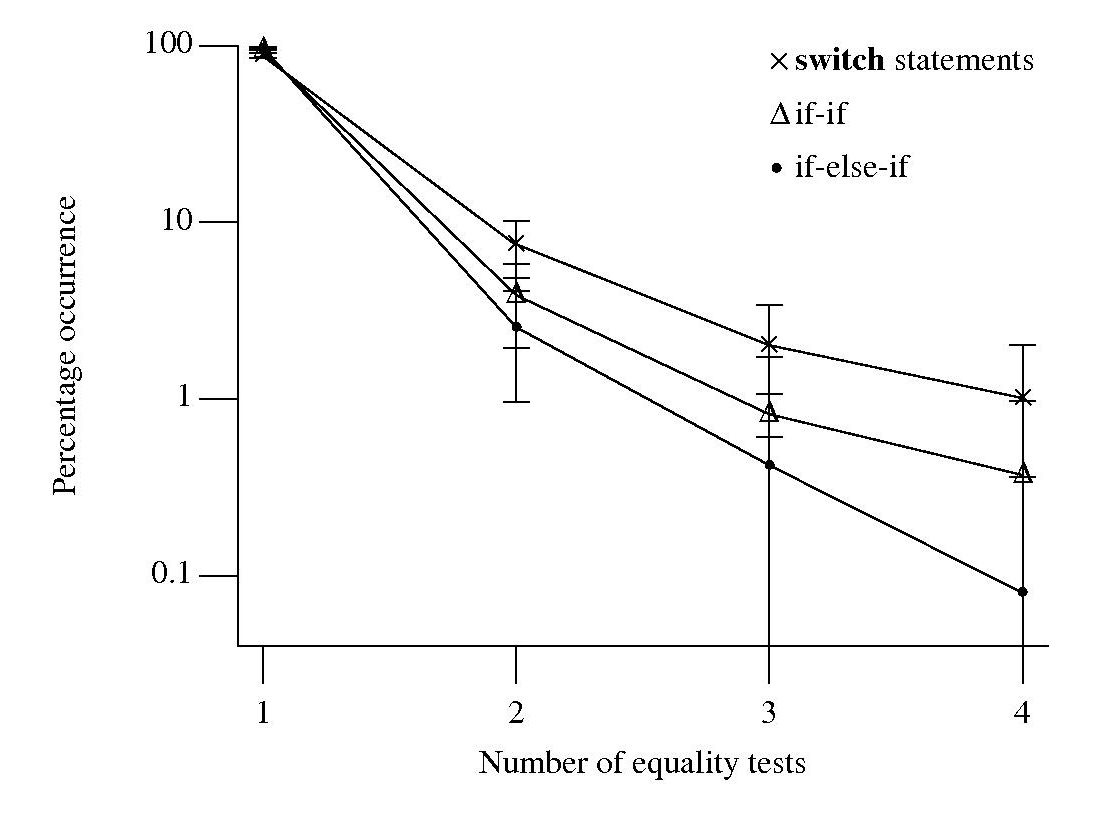Archive
To if-else-if or if-if, that is the question
I am currently measuring if-statements, occurring in visible source, that might be mapped to an equivalent switch-statement. The most obvious usage to look for is a sequence of if-else-if statements that all involve the same expression being tested against an integer constant, as in
if (x == 1) stmt_1; else if (x == 2) stmt_2; else if (x == 3) stmt_3; |
Another possible sequence is:
if (x == 1) stmt_1; if (x == 2) stmt_2; if (x == 3) stmt_3; |
provided all but the last conditionally executed arms do not change the value of the common control variable (e.g., x).
I started to wonder about what would cause a developer to chose one of these forms over the other. Perhaps the if-if form would be used when it was obvious that the common conditional variable was not modified in the conditionally executed arm. This would imply that there would be more statements in the arms of if-else-if sequences than if-if sequences. The following plot of percentage occurrence (over all detected if-else-if/if-if forms) of line number difference between pars of associated if-statements (e.g., when the controlling expression occurs on line

Just over a quarter of the arms contain a single statement (or to be exact the code is contained on a single line); this suggests that when using the if-else-if form most developers put the else and if on the same line. At the next distance along the percentage of if-else-if forms is twice as great as the if-if, probably because of else and if appearing on separate lines (as in the introductory example) in one case and less frequently a comment/blank line in the other. Next along, why the big increase in if-if forms? A comment + blank line, or perhaps no comment or blank line but the use of curly brackets (this is too off the track of where I am supposed to be going to investigate).
This morning I realized why the original plot did not look right, one of the data sets was a way off adding to 100%. An updated version has been uploaded.
It turns out that a single statement (or at least a single line) is more common in the if-else-if form, the opposite of what I had expected. At slightly larger distances there are still differences that can be attributed to else and if appearing on separate lines, curly brackets and a comment/blank line, but the effect is not as large as seen in the original, less accurate, plot.
I have a feeling that I ought to say something about the if-else-if form being preferred to the if-if form. One of the forms will have its behavior changed if the common control variable is modified in one of its arms. But is this an intended or unintended behavior? What is the typical characteristic usage of a common control variable, e.g., do they tend to be accessed but not modified in a given function definition? At the moment I see no obvious cost or benefit strongly favoring one usage over the other, so I will remain silent on the issue.
Implementing the between operation
What code do developers write to check whether a value lies between two bounds (i.e., a between operation)? I would write (where MIN and MAX might be symbolic names or numeric literals):
if ( x >= MIN && x <= MAX ) |
that is I would check the lowest value first. Performing the test in this order just seems the natural thing to do, perhaps because I live in a culture that writes left to write and a written sequence of increasing numbers usually has the lowest number on the left.
I am currently measuring various forms of if-statement conditional expressions that occur in visible source as part of some research on if/switch usage by developers and the between operation falls within the set of expressions of interest. I was not expecting to see any usage of the form:
if ( x <= MAX && x >= MIN ) |
that is with the maximum value appearing first. The first program measured threw up seven instances of this usage, all with the minimum value being negative and in five cases the maximum value being zero. Perhaps left to right ordering still applied, but to the absolute value of the bounds.
Measurements of the second and subsequent programs threw up instances that did not follow any of the patterns I had dreamt up. Of the 326 between operations appearing in the measured source 24 had what I consider to be the unnatural order. Presumably the developers using this form of between consider it to be natural, so what is their line of thinking? Are they thinking in terms of the semantics behind the numbers (in about a third of cases symbolic constants appear in the source rather than literals) and this semantics has an implied left to right order? Perhaps the authors come from a culture where the maximum value often appears on the left.
Suggestions welcome.


Recent Comments